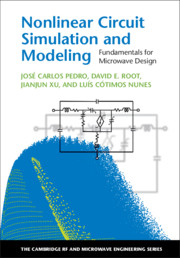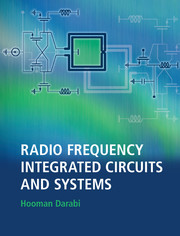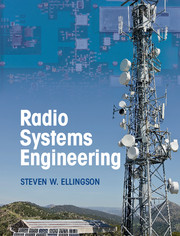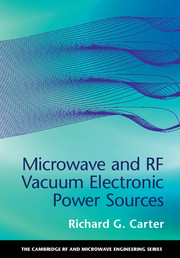Refine search
Actions for selected content:
1562 results in RF and microwave engineering
1 - Linear and Nonlinear Circuits
-
- Book:
- Nonlinear Circuit Simulation and Modeling
- Published online:
- 07 June 2018
- Print publication:
- 14 June 2018, pp 1-46
-
- Chapter
- Export citation
6 - Nonlinear Device Modeling
-
- Book:
- Nonlinear Circuit Simulation and Modeling
- Published online:
- 07 June 2018
- Print publication:
- 14 June 2018, pp 218-300
-
- Chapter
- Export citation
3 - Linear Behavioral Models in the Frequency Domain
-
- Book:
- Nonlinear Circuit Simulation and Modeling
- Published online:
- 07 June 2018
- Print publication:
- 14 June 2018, pp 93-114
-
- Chapter
- Export citation

Nonlinear Circuit Simulation and Modeling
- Fundamentals for Microwave Design
-
- Published online:
- 07 June 2018
- Print publication:
- 14 June 2018

Radio Frequency Integrated Circuits and Systems
-
- Published online:
- 28 May 2018
- Print publication:
- 16 April 2015
-
- Book
- Export citation

Radio Systems Engineering
-
- Published online:
- 28 May 2018
- Print publication:
- 06 October 2016
-
- Textbook
- Export citation

Microwave and RF Vacuum Electronic Power Sources
-
- Published online:
- 27 April 2018
- Print publication:
- 12 April 2018
5 - Thermionic Diodes
-
- Book:
- Microwave and RF Vacuum Electronic Power Sources
- Published online:
- 27 April 2018
- Print publication:
- 12 April 2018, pp 190-223
-
- Chapter
- Export citation
15 - Magnetrons
-
- Book:
- Microwave and RF Vacuum Electronic Power Sources
- Published online:
- 27 April 2018
- Print publication:
- 12 April 2018, pp 565-628
-
- Chapter
- Export citation
1 - Overview
-
- Book:
- Microwave and RF Vacuum Electronic Power Sources
- Published online:
- 27 April 2018
- Print publication:
- 12 April 2018, pp 1-40
-
- Chapter
- Export citation
17 - Fast-Wave Devices
-
- Book:
- Microwave and RF Vacuum Electronic Power Sources
- Published online:
- 27 April 2018
- Print publication:
- 12 April 2018, pp 659-693
-
- Chapter
- Export citation
9 - Electron Guns
-
- Book:
- Microwave and RF Vacuum Electronic Power Sources
- Published online:
- 27 April 2018
- Print publication:
- 12 April 2018, pp 317-351
-
- Chapter
- Export citation
12 - Gridded Tubes
-
- Book:
- Microwave and RF Vacuum Electronic Power Sources
- Published online:
- 27 April 2018
- Print publication:
- 12 April 2018, pp 433-465
-
- Chapter
- Export citation
10 - Electron Collectors and Cooling
-
- Book:
- Microwave and RF Vacuum Electronic Power Sources
- Published online:
- 27 April 2018
- Print publication:
- 12 April 2018, pp 352-374
-
- Chapter
- Export citation
Reviews
-
- Book:
- Microwave and RF Vacuum Electronic Power Sources
- Published online:
- 27 April 2018
- Print publication:
- 12 April 2018, pp ii-iv
-
- Chapter
- Export citation
4 - Slow-Wave Structures
-
- Book:
- Microwave and RF Vacuum Electronic Power Sources
- Published online:
- 27 April 2018
- Print publication:
- 12 April 2018, pp 134-189
-
- Chapter
- Export citation
Principal Roman Symbols
-
- Book:
- Microwave and RF Vacuum Electronic Power Sources
- Published online:
- 27 April 2018
- Print publication:
- 12 April 2018, pp xxvii-xxx
-
- Chapter
- Export citation
Abbreviations
-
- Book:
- Microwave and RF Vacuum Electronic Power Sources
- Published online:
- 27 April 2018
- Print publication:
- 12 April 2018, pp xxxiii-xxxiv
-
- Chapter
- Export citation
14 - Travelling-Wave Tubes
-
- Book:
- Microwave and RF Vacuum Electronic Power Sources
- Published online:
- 27 April 2018
- Print publication:
- 12 April 2018, pp 507-564
-
- Chapter
- Export citation
18 - Emission and Breakdown Phenomena
-
- Book:
- Microwave and RF Vacuum Electronic Power Sources
- Published online:
- 27 April 2018
- Print publication:
- 12 April 2018, pp 694-734
-
- Chapter
- Export citation
